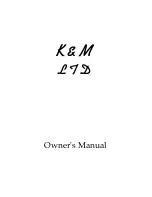
XZR200 User’s Manual
Michell Instruments
15
GOOD MEASUREMENT PRACTICE
5.2.2 Protecting from Water Droplets
In environments where falling water droplets are likely, the sensor should be protected
from water falling directly onto the very hot sensor cap as this can cause massive
temperature shocks to the cell and heater. Popular methods include a hood over the
sensor cap or for the sensor to be mounted in a larger diameter cylinder.
At a very minimum the sensor cap should be angled downwards in the application as
this will de
fl
ect any falling moisture and prevent the sensor cap from
fi
lling with water
(see Section 3, Installation).
5.2.3 Cross Sensitivity With Other Gases
Gases or chemicals that will have an in
fl
uence on the life of the sensor or on the
measuring results are:
1. Combustible
Gases
Small amounts of combustible gases will be burned at the hot Platinum
electrode surfaces or Al2O3
fi
lters of the sensor. In general, combustion
will be stoichiometric as long as enough oxygen is available. The sensor
will measure the residual oxygen pressure which leads to a measurement
error (low oxygen reading). The sensor is not recommended for use in
applications where there are large amounts of combustible gases present
and an accurate O
2
measurement is required.
Gases tested:
•
H2 (Hydrogen) up to 2%; stoichiometric combustion
•
CO (Carbon Monoxide) up to 2%; stoichiometric combustion
•
CH4 (Methane) up to 2.5%; stoichiometric combustion
•
NH3 (Ammonia) up to 1500 ppm; stoichiometric combustion
2. Heavy
Metals
Vapors of metals like Zn (Zinc), Cd (Cadmium), Pb (Lead) and Bi (Bismuth)
will have an effect on the catalytic properties of the Pt– electrodes. Exposure
to these metal vapors must be avoided.
3.
Halogen and Sulphur Compounds
Small amounts (< 100ppm) of Halogens and/or Sulphur compounds have no
effect on the performance of the oxygen sensor. Higher amounts of these
gases will, in time, cause readout problems or, especially in condensing
atmospheres, corrosion of sensor parts. These gases often outgas from
plastic housings and tubes when hot.
Investigated gases were:
• Halogens,
F
2
(Flourine), Cl
2
(Chlorine)
•
HCL (Hydrogen Chloride), HF (Hydrogen Fluoride)
• SO
2
(Sulphur Dioxide)
• H
2
S (Hydrogen Sulphide)
• Freons
• CS
2
(Carbon Disul
fi
de)
Summary of Contents for XZR200
Page 1: ...XZR200 Oxygen Analyzer User s Manual 97337 Issue 4 July 2018 ...
Page 24: ...XZR200 User s Manual Michell Instruments 17 CALIBRATION Appendix A Technical Specifications ...
Page 27: ...XZR200 User s Manual 20 97337 Issue 4 July 2018 APPENDIX B Appendix B Theory of Operation ...
Page 35: ......
Page 36: ...http www michell com ...















































